What To Expect From Future Traceability Regulations

The Canadian Sheep Federation (CSF) has engaged with the CFIA through two rounds of national consultations in 2013 and 2015 on proposed amendments to the Health of Animals Regulations dealing with livestock identification and traceability
Through the Regulatory Implementation Committee, national industry associations including the CSF, provinces and the federal government are preparing the implementation of the proposed regulations in order to ensure compliance with the new proposed requirements and message consistency. What follows provides insight into what’s to be expected from amended traceability regulations.
Proposed regulations are expected to be published in Part I of the Canada Gazette in the spring or fall 2018, providing greater detail about specific requirements. There will be a 75 day comment period following publication in Part I of Canada Gazette, and the CSF will continue to advocate for the interests of Canadian sheep farmers and ranchers as regulations are finalized.
“Effective traceability can better protect public health and support industry market access, competitiveness and consumer confidence”
Objectives, Goals, Current Gaps
1. The objective of the livestock traceability system is to provide timely, accurate and relevant information to reduce the impacts of a disease outbreak, food safety issue or natural disasters originating from and /or affecting livestock.
Effective traceability can better protect public health and support industry market access, competitiveness and consumer confidence.
2. Four gaps that have been identified in the current livestock identification and traceability
program, include;livestock species that share diseases are not all subject to traceability requirements;
the time period provided to report an event to a responsible administrator is too long too
support an efficient response to disease outbreaks, or natural disasters;
information about the geographical location of sites (premises) where animals are located is limited; and,
information about the domestic movements of livestock is unknown or not readily available.3. The proposed livestock traceability regulation amendments will align with livestock identification and traceability requirements already adopted by provincial and territorial governments.
Engagement, Partnership
4. The objective of the proposed regulatory amendments is to address the gaps previously identified during consultations in 2013 and 2015.
5. An industry-government Regulatory Implementation Committee has been formed with the objective to collaboratively identify and prioritize actions to help prepare for a smooth implementation of proposed amendments to the Health of Animals Regulations.
Proposed Requirements: Animal Identification6. The proposed regulatory amendments include identification requirements for goat, farmed deer, and elk thereby broadening the scope of activities and animals that are subject to traceability requirements. Identification requirements for bison, cattle, sheep and pigs are already covered under the Health of Animals Regulations.
Proposed Requirements: Premises Identification
7. A premises is a land parcel where farm animals are kept, assembled or disposed of.
8. Each province issues premises identification numbers. A premises identified by a provincial or territorial government will not be required to be re-identified through the proposed federal regulations.
9. Under the proposed regulations, persons who own or have the care or control of livestock will be required to provide the premises identification number for the location where approved indicators are applied to their animals. Should the animals be moved, to a new location, outside of the farm operation, the premises identification number for the destination location will also need to be provided.
10. Under the proposed amendments, a unique premises identification number is provided once information about the specific premises is validated by the provincial or territorial government where it is located. Examples of what must be received, include;
contact information,
location of the premises,
type of agricultural and agri-food operation on site, and
animal species kept on the premises.Proposed Requirements: Movement Reporting
11. Under the proposed amendments, with some exemptions, the domestic movement for all regulated species will be required to be reported.
12. Under the proposed amendments, the allowable time to report the movement or death of animals to the responsible administrator will be reduced to seven (7) days from 30 days.
Proposed Requirements: Documentation
13. Under the proposed amendments certain information will be required to accompany a load of animals and/or animal carcasses being transported. The format/media on which the information should be provided will not be prescribed within the regulations, but could include paper or electronic forms.
14. Under the proposed amendments, the federal requirement for information to accompany animals and carcasses will not apply for species where similar provincial regulatory requirement already exist.
15. To support transporters with compliance in provinces that do not currently require any movement documentation, a voluntary movement document template will be made available.
Milestones and Timelines
16. The proposed regulations are expected to be published in spring or fall 2018. Following the publication of the proposed regulations in Part I of the Canada Gazette (http://www.gazette.gc.ca/rp-pr/publications-eng.html#a1), stakeholders will have 75 days to review and provide comment.
17. CFIA will review and consider all comments received prior to finalizing the regulation amendments and publishing them in Part II of the Canada Gazette. Once published in Part II of the Canada Gazette, the regulations will be considered final and immediately come into force
source: The Canadian Sheep Federation (CSF)












